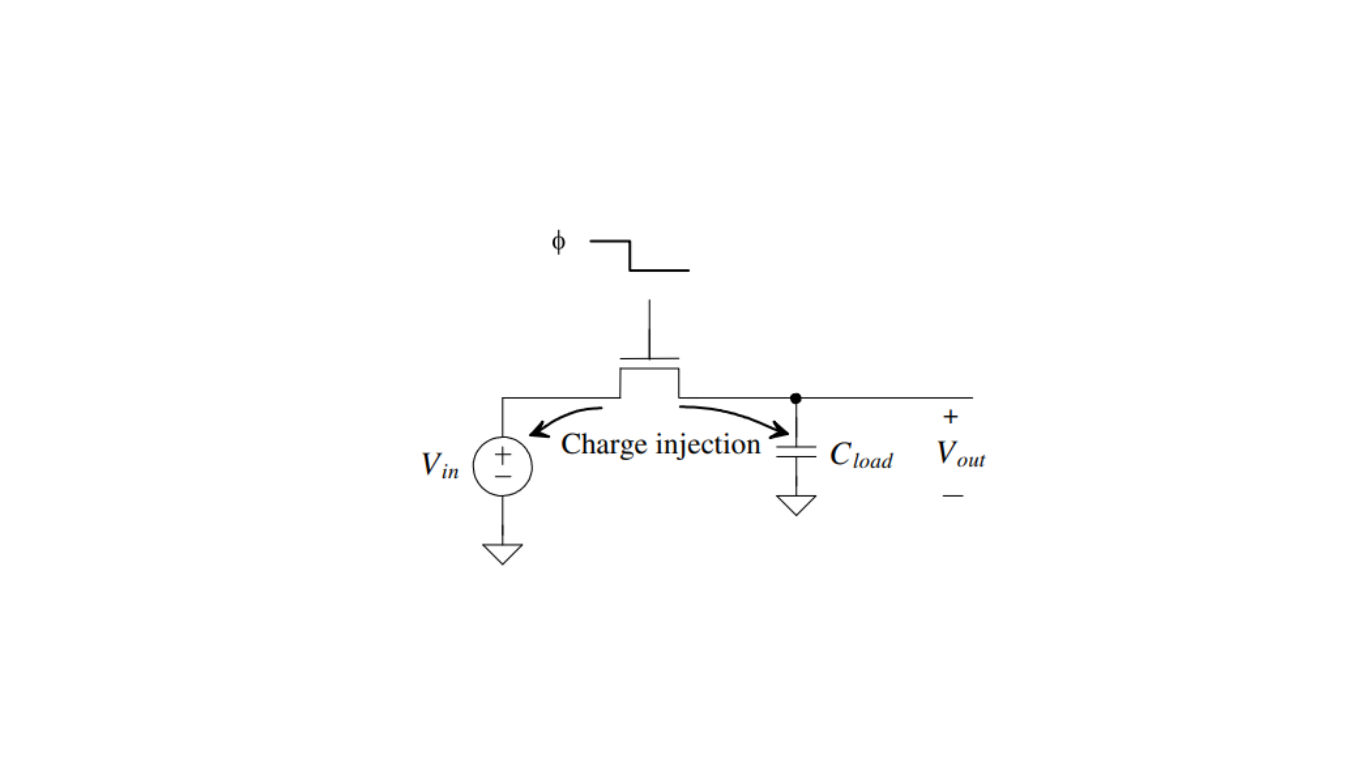Charge injection
Charge injection is a phenomenon encountered in MOSFET switches, and it plays a crucial role in analog and mixed-signal circuits. To grasp the concept of charge injection, consider the scenario illustrated in the figure

Charge injection, as the term suggests, involves the transfer of charge during the operation of electronic devices, primarily MOSFETs. When a MOSFET switch is turned on and the voltage between the drain and source terminals (VDS) is small, charge accumulates beneath the gate oxide, forming what is known as Q’ch.
Switching On: When the MOSFET switch is turned on (in the conducting state) with a small drain-source voltage (VDS), an inverted channel is formed beneath the gate oxide. This channel carries a certain amount of charge, denoted as Q’ch. This charge exists under the gate and is related to the channel conductance.
Switching Off: When the MOSFET turns off (goes from the conducting to non-conducting state), the charge Q’ch that was stored under the gate oxide is injected into a connected capacitor (Cload) and into the input node (Vin).
- Effect on Vin: Typically, Vin is assumed to be a low-impedance, source-driven node. As a result, the injected charge has minimal to no effect on Vin.
- Effect on Cload: However, the charge injected into Cload leads to a change in voltage across this capacitor. This voltage change can be substantial, especially when the injected charge is significant.
It’s worth noting that charge injection also occurs in the opposite direction when the switch turns on. Nevertheless, this is generally less concerning because the input voltage is connected to Cload through the channel resistance, which mitigates this effect. The channel resistance allows the voltage across Cload to charge to Vin without significant distortion.
Charge injection is a complex phenomenon, but it has been extensively studied to understand and minimize its impact. One key observation is that the speed at which the clock signal turns off plays a role in how channel charge is distributed. In particular, if the clock signal switches off rapidly, the channel charge distributes more evenly between adjacent components.
In summary, charge injection is a critical consideration in analog and mixed-signal circuit design. It can introduce nonlinearity and distortion, particularly when the clock signals switch rapidly. Minimizing charge injection effects is essential to ensure the accuracy and linearity of analog circuits.
What happens to the charge under the gate oxide when the MOSFET switch turns off?
When the MOSFET switch turns off, the charge accumulated under the gate oxide is injected into the capacitor and into Vin, the input voltage node. This injection of charge can have significant implications for electronic circuits.
How does the impedance of Vin affect the injected charge in MOSFET switching?
Vin is assumed to be a low-impedance, source-driven node. As a result, the injected charge has no effect on this node. However, it does impact C loud, resulting in a change in voltage across it.
What is the significance of signal dependency in charge injection, and how does it relate to harmonic distortion?
Signal dependency in charge injection means that the degree of injection varies with the characteristics of the input signal. This variation can lead to harmonic distortion, which can affect the accuracy of electronic circuits, particularly when the charge injection is signal-dependent.
How does the complementary clock signal play a role in reducing charge injection when using CMOS transmission gates?
When using CMOS transmission gates, complementary clock signals are employed to minimize charge injection and clock feedthrough. These complementary signals act to cancel each other out, resulting in lower changes in Vout. However, this method requires precise control of the complementary clocks, and it assumes that the input signal, Vin, is small, as the effectiveness of this approach relies on the symmetry of the turn-on and turn-off waveforms, which is influenced by the input signal.
What are the key advantages of using a dummy switch in charge injection management compared to other methods?
The dummy switch method offers an effective way to cancel out charge injection by matching the charge injected by the primary switch (M1) with the charge induced by the dummy switch (M2). This method is particularly advantageous as it does not rely on the precise timing of clock signals and is less dependent on the input signal’s amplitude.